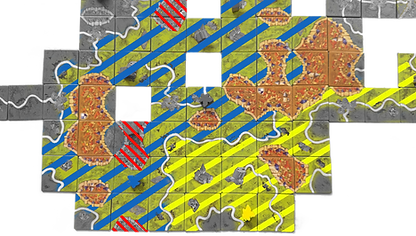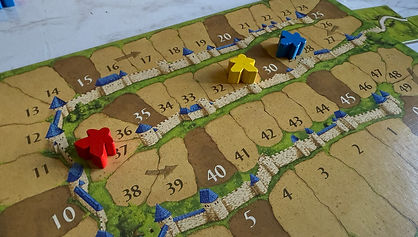
LET'S PLAY
CARCASSONNE

Carcassonne is one of the best board games out there—simple to learn, strategic, and endlessly replayable. It’s a game of medieval city-building where players place tiles, claim roads, cities, and fields with their meeples, and rack up points through clever positioning. Whether you’re cutting off an opponent’s city or expanding your own, every tile placement counts

Object
Score the most points by the end of the game.
Points are made by strategically placing tiles to build medieval cities, roads, monasteries, and fields while using their Meeples (player tokens) to claim areas and earn points.
What You Need
2 to 5 players, but 3 to 4 is the sweet spot for strategy without it feeling too crowded.
72 Tiles depicting cities, roads, fields, and monasteries
Meeples: Each player gets seven meeples in their color, plus an extra one for scoring
Scoreboard: Tracks player points as the game progresses
Set Up
-
Place the starter tile (marked with a darker back and lighter letter "C") in the center of the table.
-
Shuffle the remaining tiles and stack them face-down.
-
Each player takes seven meeples in their color and places one on the scoreboard.
Game Play
Turn Actions
On Your Turn, do the following:
Draw a Tile:
Pick a tile from the stack and flip it over.
Place the Tile:
Connect the new tile to an existing one, ensuring roads connect to roads, cities to cities, and fields to fields.
Deploy a Meeple (Optional):
Place one meeple on the tile to claim a feature (road, city, monastery, or field), but only if that feature and it's connected tiles aren't already claimed.

Starter tile.

Complete guide to Carcassone

Tile Features
Roads:
The simplest feature. Roads connect from one tile to another and are completed when both ends are closed (by a city, monastery, or looping back). Each tile in a completed road is worth 1 point.
Cities:
Walled sections that grow as you place more tiles. A city is completed when it’s fully enclosed by walls. Completed cities score 2 points per tile, with an extra 2 points for each shield inside. Incomplete cities at the end of the game score 1 point per tile.
Monasteries:
Monastery (aka cloister) is a single-tile feature that scores big if surrounded. When all 8 adjacent tiles are placed, it’s complete and earns 9 points (1 for each surrounding tile + the monastery itself). If unfinished at the end of the game, it still earns 1 point per adjacent tile.
Fields:
The long game. Fields are claimed by placing a farmer (a meeple laying down). They stay there until the game ends and score 3 points for every completed city they touch. Positioning farmers well can be a game-winner. Be careful though, other players can rob your fields by connecting connected fields with more of their meeples than yours, stealing your points.



Scoring
Roads:
Completed roads (both ends closed) earn 1 point per tile.
Cities:
Completed cities earn 2 points per tile, with an extra 2 points per shield.Monasteries: Surrounded monasteries score 9 points (1 for each surrounding tile, plus the monastery itself).
Farms:
Farmers score 3 points per completed city they touch, but only at the end of the game.

More on Fields and Farmers
Fields are the most strategic and long-term scoring feature in Carcassonne. A field is any connected grassy area, and you claim it by placing a farmer (a meeple laid down) on your turn. Unlike roads, cities, or monasteries, farmers stay on the board until the game ends, meaning you don’t get them back once placed.
Farmers score 3 points for every completed city that touches their field, regardless of how many tiles the city takes up. A completed city is fully enclosed by walls with no open edges, but a farmer’s field doesn’t need to surround the entire city for it to count—just touching any part of the city is enough. Fields are separated by roads and city walls—if a road or city wall cuts through the grass, that’s the boundary, and the farmer only controls the specific uninterrupted grassy area they were placed in.
Dominance matters: if multiple players have farmers in the same field, the player with the most farmers gets all the points. If tied, both players get full points.
A well-placed farmer in a large, city-heavy field can swing the game, but committing too early can leave you short on meeples for the rest of the match.



Strategy: Dominance
Dominance is one of the most important strategies in Carcassonne and can make the difference between winning and losing.
When a feature like a road, city, or field is completed, the player with the most meeples on that feature scores all the points. If tied, all tied players get the full score. Since you can’t place a meeple on a feature that already has one, the key to stealing or sharing a scoring opportunity is placing your meeple on a separate, unoccupied section and then later connecting it to the feature.
For example, if an opponent is building a huge city, you can place a meeple in a separate city section and then connect the two cities with a well-placed tile, forcing a tie or taking control if you have more meeples.
The same works for roads and fields—find an open section, claim it, then connect it later.
However, dominance isn’t just about stealing—sharing a large feature can sometimes be better than fighting over control, especially in multiplayer games where a third player could swoop in. Knowing when to join, compete, or let an opponent overextend is key to mastering Carcassonne.
End of Game
The game ends when all tiles are placed. Players then score incomplete features at a reduced rate:
Incomplete roads/cities:
1 point per tile.
Incomplete monasteries:
1 point per adjacent tile.
Farmers score as usual:
3 points per completed city touching their field.
Shared features both get the same point value (it's not split in half).
Dominance on features get all the final points.
The player with the highest score wins!

Great Game Needs A Great Title

Final Thoughts
Carcassonne isn’t just a great game—it’s one of the greatest of all time. It nails that perfect balance between strategy and simplicity, where new players can jump in fast, but experienced players can pull off some truly savage moves. Every game unfolds differently, every tile placement matters, and every meeple you commit is a gamble. It’s cutthroat without being cruel, competitive without dragging, and just flat-out fun. If you haven’t played it yet, fix that. You’ll thank me later.






